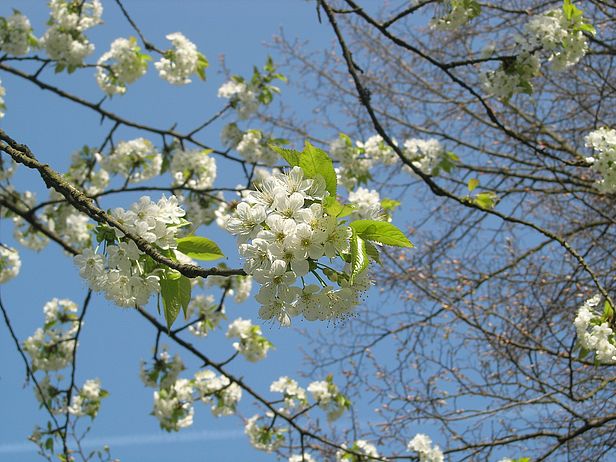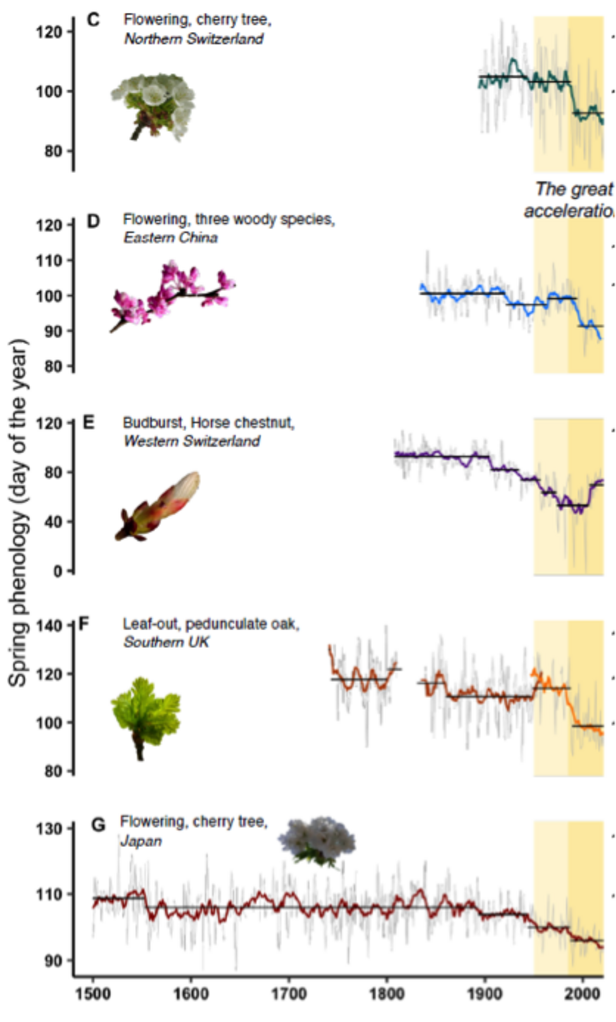06.04.2022 | Beate Kittl | News WSL
A research team led by the Swiss Federal Institute for Forest, Snow and Landscape Research WSL now presents the world’s five longest time series on spring budburst of trees in Nature Climate Change. Among them are a cherry tree in Basel-Landschaft and a horse chestnut in Geneva. The advance in the timing of leaf emergence or flowering observed in all series is a clear sign of climate warming that has accelerated since the 1980s.
Because temperatures are getting warmer in spring, many biological phenomena also take place earlier, for example the breeding of birds or the onset of flowering and leaf-out of trees. People have been observing these natural events for centuries, and the world’s five longest time series are presented here. All of them are strikingly consistent with the acceleration of global warming from the 1950s, which again intensified in the 1980s.
By far the longest time series is that of the cherry blossom in Kyoto, Japan, which is an important cultural occasion, the beginning of which has been recorded since 812 AD. The oldest time series in Europe is that of the Marsham family, who recorded the leaf-out of several deciduous trees in the south-east of Great Britain from 1736 to 1958. Nearby, the local resident Jean Combes has been recording the leaf emergence of oaks and other tree species since 1950. "The contribution of citizens to these long-time series is invaluable," says lead author Yann Vitasse from the Ecosystem Ecology Research Group at WSL.
No fewer than two of the five time series are located in Switzerland: the Grand Conseil de la République et canton de Genève has been monitoring a horse chestnut (the “Marronnier de la Treille”) [YV1] since 1808, and the Landwirtschaftliches Zentrum Ebenrain and MeteoSwiss have been monitoring a cherry tree in the canton of Basel-Landschaft since 1894.
Leaf-out and blooming six to 30 days earlier ¶
On average in these series, leaf-out or blooming in the period from 1985 to 2020 began six (in China) to 30 days (in Switzerland) earlier than before 1950. Particularly impressive: The cherry blossom in 2021 in Japan started earlier than ever before in the last 1200 years. Yet these five time-series are not even located in those regions of the world where climate had warmed the most, such as in Central Asia. "There, the temporal shift of life cycle events is expected to be even more extreme," says Dr. Vitasse.
The time series of blooming and leaf-out are not only perfect indicators for science, but also an easily observable phenomenon for the general population, even for children. "These are concrete, tangible indicators for the acceleration of climate change," says Vitasse. Therefore, phenology, which refers to the science that studies biological processes in relation to seasonal climate fluctuations, could be a very good tool to communicate about the impact of climate change on living organisms. It can help raise awareness of politicians and future generations for current climate change and its impacts, according to the researchers. The commentary by the scientists from WSL, ETH Zurich, MeteoSwiss and colleagues from China, Japan, and the UK appears as part of a special issue of Nature Climate Change on phenology.
The five time series: c) Bloom onset of wild cherry trees in Liestal, BL (1894-2020), d) Bloom onset of three woody species in China (1834-2020), e) Leaf emergence data of a horse chestnut in Geneva (1808-2020), f) Leaf emergence of pedunculate oak in Great Britain of the Marsham family (dark orange; 1736-1958) and J. Combes (light orange; 1950-2020), g) Bloom onset of Yamazakura cherry trees in Kyoto, Japan (1500-2020). The left axis shows the day of the year when the tree buds burst or bloom. The grey thin lines represent interannual variability, thick lines are 10-year moving averages. Graphic: Yann Vitasse
Contact ¶
Links and documents
Vitasse, Y., Baumgarten, F., Zohner, C.M. et al. The great acceleration of plant phenological shifts. Nat. Clim. Chang. 12, 300–302 (2022). https://doi.org/10.1038/s41558-022-01283-yG
Copyright ¶
WSL and SLF provide the artwork for imaging of press articles relating to this media release for free. Transferring and saving the images in image databases and saving of images by third parties is not allowed.


